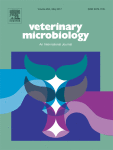View Item
- xmlui.general.dspace_homeCentros Regionales y EEAsCentro Regional Santa FeEEA RafaelaArtículos científicosxmlui.ArtifactBrowser.ItemViewer.trail
- DSpace Home
- Centros Regionales y EEAs
- Centro Regional Santa Fe
- EEA Rafaela
- Artículos científicos
- View Item
Immune response of Staphylococcus aureus strains in a mouse mastitis model is linked to adaptive capacity and genotypic profiles
Abstract
Staphylococcus aureus is one of the most frequently isolated major pathogens from intramammary infections (IMI) worldwide. The mechanisms by which S. aureus IMI are established and maintained in dairy cows involve both bacterial escape strategies and modulation of the host immune response. Moreover, it was shown that different S. aureus strains have varying effects on the immune response. The aim of this study was to investigate the immune response in a
[ver mas...]
Staphylococcus aureus is one of the most frequently isolated major pathogens from intramammary infections (IMI) worldwide. The mechanisms by which S. aureus IMI are established and maintained in dairy cows involve both bacterial escape strategies and modulation of the host immune response. Moreover, it was shown that different S. aureus strains have varying effects on the immune response. The aim of this study was to investigate the immune response in a mouse mastitis model of two S. aureus strains isolated from bovine IMI with different clinical manifestation (persistent-P or non-persistent-NP), phenotypic and genotypic profile. Both strains were
capable of establishing an IMI after 264 h post inoculation (pi). Strain A (NP) showed a more aggressive
behaviour than strain B (P) at early stages of IMI, while strain B multiplied initially at a lower rate but increased
its replication capacity from 120 h pi to the end of the study (264 h pi). Strain A triggered a stronger initial
inflammatory response compared with strain B inducing higher gene and protein expression of TLR2, NF-κB
activation and higher gene expression of IL-1α at initial stage of IMI (6–12 h pi) but inducing extensive mammary tissue damage. Immune cells response was different for each S. aureus strain throughout the course of infection, showing mammary glands inoculated with strain A greater initial immune cells stimulation compared
with strain B and then a second immune cells stimulation (from 120 to 264 h pi) represented by CR Bs.As.Sur_EEA Balcarce_Garcia_JA_Retrospective analysis of cattle poisoning in Argentina onocytesmacrophages, T and B lymphocytes, mainly stimulated by strain B, consistent with inflammatory process becoming chronic. Strain-specific pathogenicity observed underscores the importance of pathogen factors in the progression of the infectious process. These results contribute to increase the available information on hostpathogen interaction and point out for the need of further research to expand the knowledge about these interactions for developing new strategies to intervene in the IMI progress.
[Cerrar]

Author
Pereyra, Elizabet Amanda Lorena;
Sacco, Sofía Clara;
Dure, Andrea;
Baravalle, Celina;
Renna, María Sol;
Andreotti, Carolina Soledad;
Monecke, Stefan;
Calvinho, Luis Fernando;
Dallard, Bibiana Elisabet;
Fuente
Veterinary Microbiology 204 : 64-76
Date
2017
ISSN
0378-1135
Formato
pdf
Tipo de documento
article
Palabras Claves
Derechos de acceso
Restringido
 Excepto donde se diga explicitamente, este item se publica bajo la siguiente descripción: Creative Commons Attribution-NonCommercial-ShareAlike 2.5 Unported (CC BY-NC-SA 2.5)
Excepto donde se diga explicitamente, este item se publica bajo la siguiente descripción: Creative Commons Attribution-NonCommercial-ShareAlike 2.5 Unported (CC BY-NC-SA 2.5)

